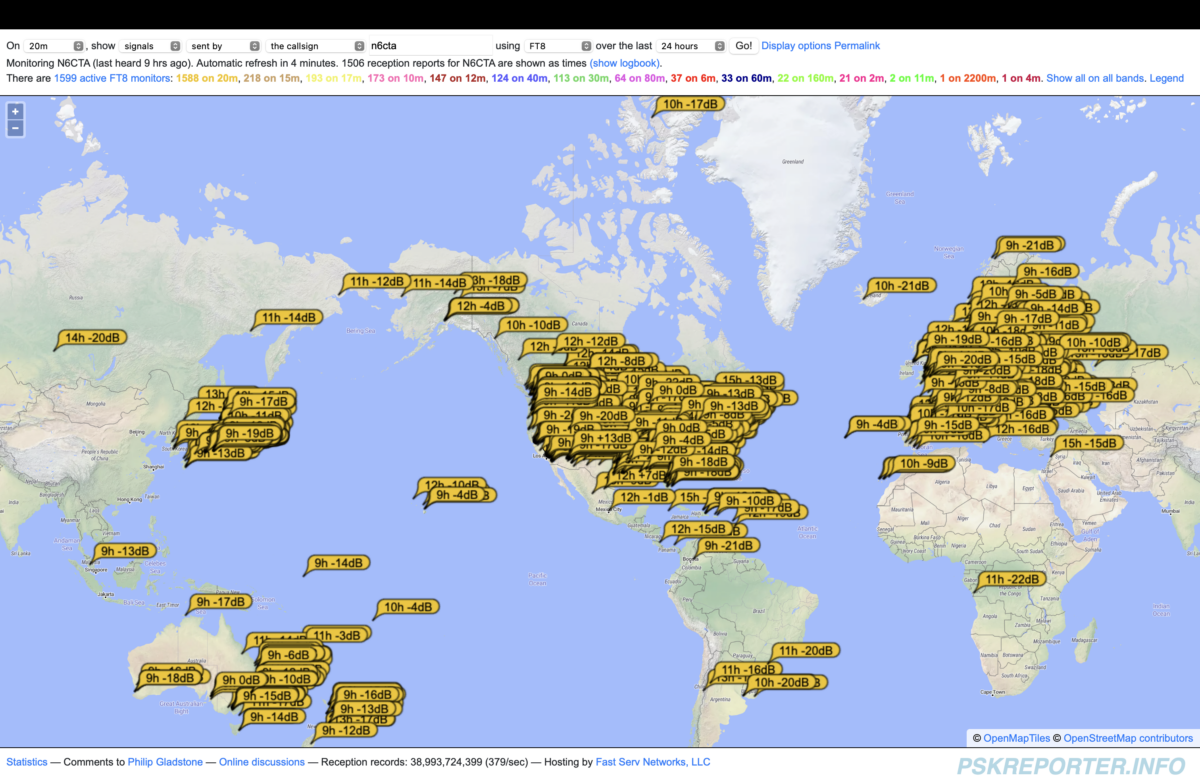There are some out there who would discount earning DXCC or other DX awards via weak signal digital modes as if there wasn’t any skill involved but it’s an asinine opinion. I can work, log, and confirm more individual DXCC entities in a couple hours of good high band conditions under non-contest or DXpedition conditions than any CW or SSB operator and it has very little to do with weak signal operation. With regards to FT8, everything about it is superior to CW or SSB when you’re trying to prove that your station made contact with another station. With FT8, WSJT-X acts as a skimmer, signal reports are meaningful, the confirmation rate is much higher, and it removes human error in the exchange. Here are some tips for working DX and FT8.
Location, location, location:
Where you are in the world and your proximity to areas with many highly populated DX entities makes all the difference. If you’re like me though and you live on the West Coast of the US, you have to work a little harder at it. That doesn’t mean go out and buy an amp, that means you need to actually need to set your station up to the best of your abilities for DX and operate on a scientific basis to have consistent success. One of the best things you can do here short of buying a property to set up an antenna farm is set up your antenna with the clearest view to the horizon in all directions on your property.
DX friendly antennas for normie DIYers:
Horizontal Dipole:
Hang it as flat as you can λ/2-1λ high for good low angle radiation.
Vertical Dipole:
Hang it so that the feedpoint is λ/2-1λ high for good low angle radiation and keep the feedline away from the radiating elements.
Ground Mounted λ/4 Vertical:
You should have a minimum of 16 x λ/4 long radials to make the most of this antenna. If you can’t fit long radials, a dense 32 x λ/8 long radial field is always better than a sparse but long radial field. Additionally, a lack of radials in a specific area will make it worse in that direction. Radials don’t increase antenna gain, they only reduce ground loss.
Elevated λ/4 Vertical:
Get it up as high as you safely can. It still should have 8-16 tuned radials for good efficiency/low SWR bandwidth.
Nonresonance:
All of the above antennas can be made nonresonant to cover multiple bands without drastically changing the radiation patterns. Height AGL will still be a factor for pattern consideration though. For nonresonant verticals, remote tuners at the feed point are the best way to go.
Reduce all RF noise under your control:
This is one of the most helpful things you can do for your station. Use an HF friendly SDR receiver and a DIY HF RDF antenna to scope out your property and reduce all RFI using Mix 31 ferrite chokes. I would also advise the use of 1:1 Guanella chokes at the feedpoint of most antennas. Not only will this reduce common mode noise on your feedline but it’ll also keep your antenna pattern from getting wonky due to common installation imperfections. Take a look at K9YC’s DIY choke guide.
Use the lowest loss transmission line you can afford:
With dipoles it’s fairly cheap and easy to DIY your own open wire line but for other types of coax fed antennas, the best value low loss coax is Davis RF Bury-FLEX. You can get most Davis RF products through Ham Radio Outlet.
Use space weather data to inform your operation:
This is probably the second most important thing you can do to not waste time operating when conditions are suboptimal. You can read more about this in this post here. When conditions are good be prepared to sit down and crank out the contacts if you want to make progress on a specific award quickly. You can finish half a band’s DXCC slots in an afternoon sometimes.
Optimize your RX/TX for maximum dynamic range:
To ensure that people can decode your signal far and wide, and likewise so that you can decode theirs, optimizing your audio levels for maximum dynamic range is fairly important. I wrote about this here.
Use spotting tools:
When you’re just starting a band it’s very easy to find unworked slots. After a while though, it really behooves you to use software like GridTracker and HamAlert to notify you of when a DX entity station you haven’t worked yet is online. You can even set the software to exclusively notify you of spots you’ve reported so that you know you can hear them.
Configure your station to be remotely operated:
I operate my Raspberry Pi station computer exclusively headless using VNC. This allows me to hop on the radio remotely from anywhere in the world, even from my cellphone, and operate when conditions are good.
Call the DX off their FT8 TX frequency:
Doing this allows you to break through to the DX station when there is a pileup on the DX’s TX slot. Be aware that a clear spot may not be clear on their end. Try several different spots in the RX passband and check PSKreporter to see where you are being heard best in the region.
Closing Thoughts:
You don’t have to do all of these things to make DX contacts but doing them will increase your odds significantly and make you a better operator in the process. You’ll notice that I didn’t mention radio brands, price points, or specific power levels. That’s because these things are largely irrelevant unless there is a disastrous flaw with the radio or conditions are very poor. This should be doable anywhere from 5-100W when you set it up right and work smart.
